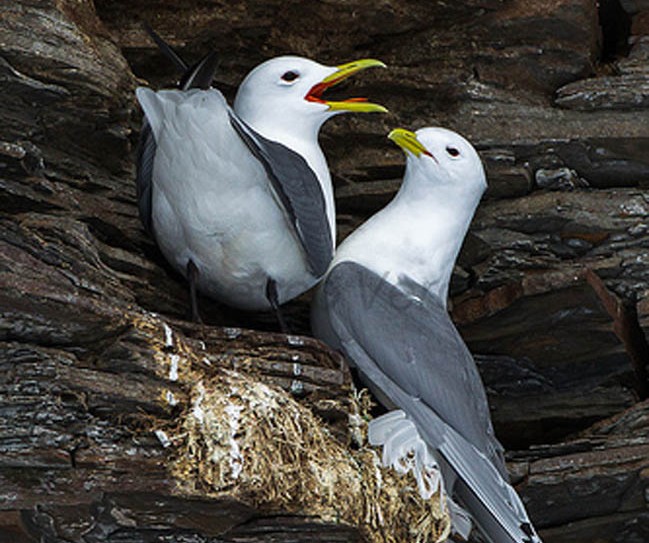Seabird colonies all over the Northern Hemisphere are starting to come alive again with the sound of birds, and there are reports of kittiwakes, puffins and auklets back on the cliffs at the Pribilof Islands. Yay! The bird’s arrival coincides perfectly with the school field trip to the St. Paul cliffs next week, and we’re excited to finally get out there and meet some of the birds we’ve been learning about…
The bird’s arrival coincides perfectly with the school field trip to the St. Paul cliffs next week, and we’re excited to finally get out there and meet some of the birds we’ve been learning about…
Both species of kittiwakes (black- and red-footed) breed on the Pribilofs. Even though black-legged kittiwakes in Alaska usually return to their breeding cliffs in May, egg-laying doesn’t usually doesn’t start until early-mid June. Birds breed earlier in more southern colonies.
The cliffs are hot with courtship and home-making… here’s a quick low-down on some key kittiwake pre-breeding preparation and mating behavior…
- Colony Attendance: A fancy-phrase biologists use to describe the amount of time birds spend at the colony (versus out at sea). Attendance at the colony is highly variable among days until about two weeks before laying…. on some days the cliffs are alive with the raucous sound of birds, whereas the same areas may be eerily empty on other days.
- Pair Bonds: (do partners stay together over multiple years?). Around 50-80% of kittiwakes remain with the same partner among years, although it doesn’t look like partners stick together during their winter months out at sea.
- Courtship displays: Males advertise to females by a strange behavior called “choking” (without any food involved). Wining and dining: Kittiwakes also beg (female asks male for food) and feed (male regurgitates food to female) during courtship.
- Nest building: Both male and female build their nest. They build a platform made out of mud and vegetation, and trample out a bird-sized bowl with their feet. Nest material (vegetation, seaweed, feathers) is carried in their bill, and birds often save time by stealing nesting material from neighbor’s nests!
- Nest choice: Birds return to the colony and hang out at least one year before they start breeding. Males usually choose a nest, and then attract their girl. Location location: birds prefer nest-sites in the center of the colony (probably less risk of predation).
- Copulation (mating): Some seabirds (such as puffins) copulate on the water, but kittiwakes copulate on the cliffs. Both male and female do a head-bobbing behavior before copulation, and the female often begs for food.
- Egg-laying: Kittiwakes may lay 1 to 3 eggs, and there is usually a 2-3 day gap between each egg.

